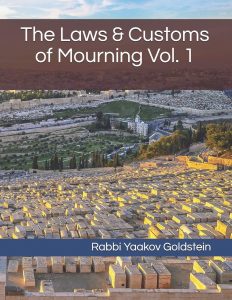6. Preparing for the Taharah and the adherences:
Prior to beginning the Taharah, all items that will be needed throughout the Taharah are to be prepared and ready for use.[1] The people doing the Taharah are to verify the name, and name of the mother, of the deceased in order to say it within the customary prayers recited.[2] Whenever the name is mentioned, it is mentioned plainly without mentioning any titles, such as Gaon and Rav.[3]
Immersing in a Mikveh beforehand: Those performing the Taharah are to immerse in a Mikveh beforehand, as stated above.
Hat and Gartel:[4] Some are accustomed to wear a hat and Gartel while performing the Taharah.
Washing hands:[5] Prior to the Taharah, each member is to wash their hands three times, as is done upon awakening in the morning. [They are not to dry their hands from this washing.[6]] After the washing the prayer recorded in Mavor Yabok is recited. [After the Chevra Kadisha completes the Taharah process, they are to wash their hands three times inconsecutively, as explained in Halacha 10.]
Asking forgiveness:[7] It is proper to ask for forgiveness from the deceased prior to beginning the Taharah.
Speaking:[8] One is to beware not to speak of unrelated matters upon doing the Taharah.
Looking at face:[9] One is not to look/stare at the face of the deceased.[10] [It is thus customary for the face to remain covered throughout the Taharah, unless it is needed to be revealed for a certain purpose.[11]]
Handing an item to each other:[12] Some are accustomed not to hand each other any of the Taharah items during the Taharah process, and rather put it down first.
Prayers: After the washing, the prayer recorded in Mavor Yabok is recited. In this prayer, the word Rachamim is repeated seven times, and mentions the name of the deceased and his mother.[13] The prayers recorded in Mavor Yabok which are said during the Taharah process may not be said near feces, and thus if there is excrement on the body, it is to be covered or washed off while reciting the prayers.[14] Likewise, the private area must be covered while the prayers are recited.[15] A list of prayers is recorded at the end of this chapter.
Learning Mishnayos:[16] Some are accustomed to learning Mishnayos in a nearby room while the Taharah is being performed.
_________________________________________________________[1] Nitei Gavriel 39:5
[2] Nitei Gavriel 39:6 that so is Minhag Chabad to say the mothers name
[3] Gesher Hachaim p. 136; Nitei Gavriel 39:7
[4] Nitei Gavriel 40:8
[5] Gesher Hachaim 9:1; Darkei Chesed 11:2, p. 43; Nitei Gavriel 43:2-4
[6] Nitei Gavriel ibid
[7] Nitei Gavriel 43:1
[8] Darkei Chesed 11:2; Nitei Gavriel 40:9; 43:10 in name of Sefer Hachaim and other Poskim
[9] Horiyos 13b; Maharil Semachos; Mavor Yabok Sifsei Renanos 9; Peri Chadash O.C. 2; P”M 2 A”A1; M”B 2:2; Darkei Chesed p. 31; Nitei Gavriel 4:2 footnote 3-4; 43:12
[10] The reason: As a) one who looks at the face of a body forgets his learning. [Poskim ibid] b) It is forbidden to look at the face of a corpse as it is belittling to him.
[11] Mavor Yabok ibid; Seder Hillel Hazakein; Darkei Chesed ibid; Nitei Gavriel ibid
The reason: In addition to preventing people from staring at the face, covering the face prevents the evil forces from looking at the sins marked on the forehead of the deceased. [Mavor Yabok ibid] One must be especially careful in this matter after the Taharah, as it can lead to danger [Seder Hillel Hazakein]
[12] Poskim in Nitei Gavriel 44:9
[13] Mavor Yabok Sifsei Rinanos 10; This prayer is based on Seder Hillel Hazakein, as brought in Lechem Hapanim 452:4; See Gesher Hachaim ibid footnote 1
[14] Gesher Hachaim 9:3 Nitei Gavriel 44:16
[15] Gesher Hachaim 9:1; Darkei Chesed 11:5
[16] Nitei Gavriel 40:11


Leave A Comment?
You must be logged in to post a comment.